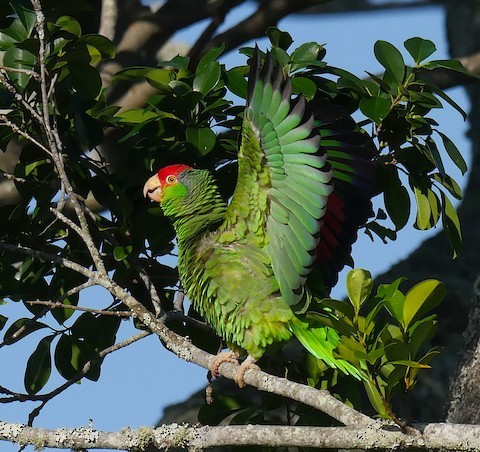Birdfinding.info ⇒ Declining and uncommon in its native Mexican range, but introduced populations are thriving in Texas and California, and to a lesser degree in Florida and Hawaii. In Mexico, wild birds can still be found in San Luis Potosí at El Naranjo and the Hotel Taninul. Among the introduced populations, local centers of abundance include: in southern Texas, downtown parks of McAllen, Weslaco, Harlingen, and Brownsville; in Florida, Palm Beach (Breakers Golf Course) and Fort Lauderdale (Richardson Park); in California, Altadena, Pasadena, Tustin, San Diego (Sea World area), and Lindo Lake, among many others; on Oahu, the hills above Pearl City (including Aiea Ridge); and on Puerto Rico, the town of Aguirre.
Red-crowned Parrot
Amazona viridigenalis
Endemic to northeastern Mexico; introduced elsewhere. Persecution for illegal cagebird trade led to a dramatic decline in its natural range, which prompted IUCN to designate it as endangered in 1994. Introduced populations now likely exceed native ones.
In its native range, it inhabits foothill forests and semiopen areas from the lower slopes of the Sierra Madre Oriental east across the coastal plain from central Nuevo León and eastern San Luis Potosí to central Veracruz. Since the 1990s most of the wild population has been limited to the central portion of its historical range, but small numbers may persist or wander throughout.
Introduced populations are established in the Lower Rio Grande Valley of southern Texas (Mission to Laguna Atascosa, plus a few in Laredo) and southern California (San Fernando east to Pomona and south to San Diego).
Smaller populations are more tentatively established in: the metropolitan areas of Saltillo and Monterrey, Mexico; southeastern Florida (Palm Beach and Fort Lauderdale), Oahu (Pearl City) and southeastern Puerto Rico (Jobos Bay).
Identification
A typically green Amazona with a prominent red forecrown and red wing-patches.
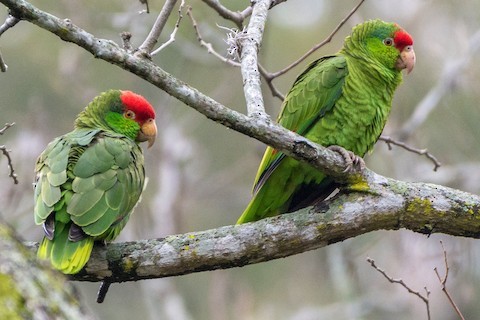
Red-crowned Parrot, pair—note the much less extensive red on the female, at right. (Hotel Taninul, Los Puentes, San Luis Potosí, Mexico; March 6, 2019.) © Juan Miguel Artigas Azas
The extent of red on the crown varies. Adult males are red from the forehead and lores to around the middle of the crown. On females and immatures, the red is more limited, covering the forehead, lores, and forecrown—usually ending around the eyes.
The rest of the crown often appears largely bluish or purplish, and the cheeks are contrastingly pale green.
The bill is pale-yellowish, and the orbital skin usually appears whitish.
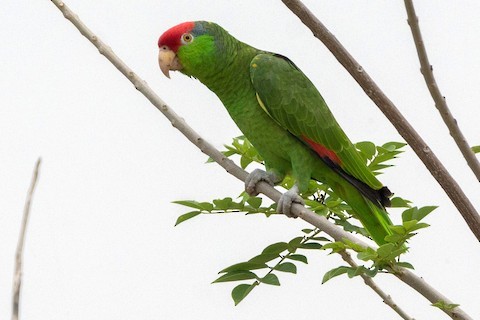
Red-crowned Parrot, male. (Hotel Taninul, Los Puentes, San Luis Potosí, Mexico; March 11, 2020.) © Juan Miguel Artigas Azas
When folded, the tail usually appears green with yellowish corners. When spread, it appears mostly yellow with a green base.

Red-crowned Parrot, showing spread tail with broad yellowish tip. (Hotel Taninul, Los Puentes, San Luis Potosí, Mexico; March 15, 2017.) © Juan Miguel Artigas Azas
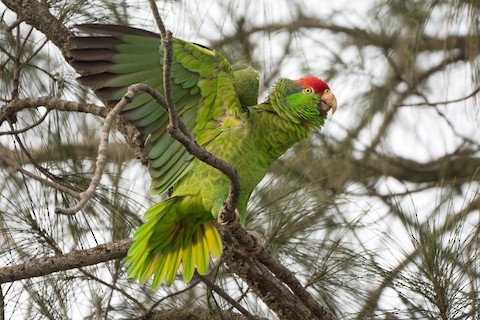
Red-crowned Parrot, showing spread tail with broad yellowish tip. (Tampico Metropolitan Park, Tamaulipas, Mexico; April 7, 2019.) © Juan Miguel Artigas Azas
A sliver of red in the wing is often visible at rest. On the fully extended wing, a red panel covers the inner portion of the six outer secondaries—with a blackish trailing edge.
The underside of the wing has yellowish-green linings and darker green flight feathers with a blackish border that is broad at the tips and narrow along the trailing edge.
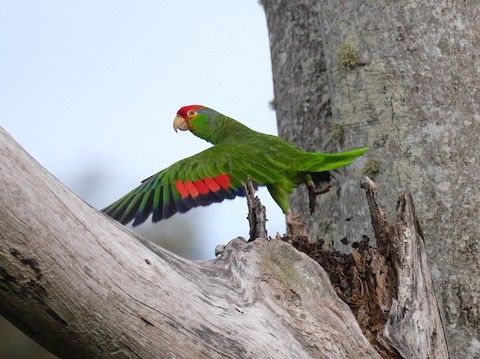
Red-crowned Parrot, male showing the red panel on its secondaries. (Waimalu, Oahu, Hawaii; March 14, 2020.) © Nick Kalodimos
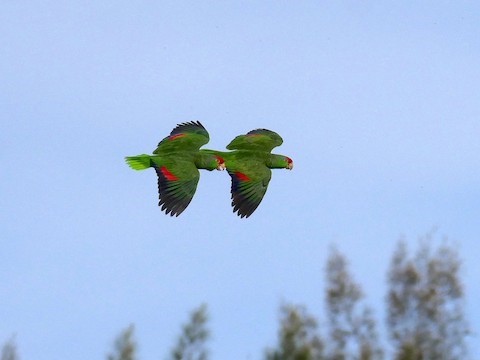
Red-crowned Parrots, pair in flight, showing red wing panels. (Waimalu, Oahu, Hawaii; March 14, 2020.) © Nick Kalodimos
Notes
Monotypic species. Also known as Green-cheeked Parrot (or Amazon).
IUCN Red List Status: Endangered.
See below for comparisons of Red-crowned Parrot with Lilac-crowned and Red-lored Parrots.
Cf. Lilac-crowned Parrot. Red-crowned and Lilac-crowned Parrots occur together in mixed flocks in some areas where both have been introduced—especially in southern California, but also to some extent in southern Texas, Florida, and Monterrey, Mexico. They are closely related, very similar, and hybridizing, which makes some individuals unidentifiable even under ideal viewing conditions.
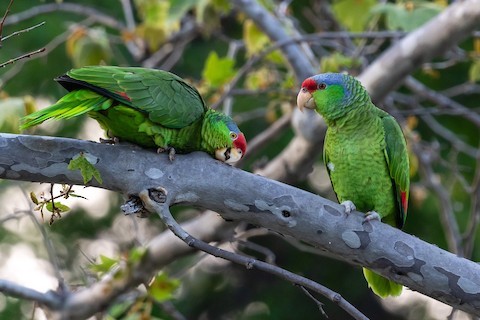
Red-crowned Parrot, female, with Lilac-crowned Parrot on right—note Lilac-crowned’s narrower red forehead and darker orbital skin. (Irvine Regional Park, Orange County, California; March 27, 2019.) © Jeff Bray
The most consistent observable differences are in head pattern and coloration—although this is complicated by variation within Red-crowned, as females and immatures have red limited to the forehead, as on Lilac-crowned. On Lilac-crowned, the red tends to appear darker and does not extend back to the eye, whereas on Red-crowned, the red usually appears more scarlet and generally extends at as far back as the eye. Red-crowned usually shows pale whitish orbital skin, whereas on Lilac-crowned the orbital skin is usually fairly dark and bluish.
True to its name, Lilac-crowned typically shows extensive purplish or bluish color on the crown, but this is not always a reliable field mark because Red-crowned can also have fairly extensive purplish or bluish color on the crown.
Cf. Red-lored Parrot. Red-crowned and Red-lored Parrots overlap naturally in northeastern Mexico and unnaturally in some parts of the U.S. where both have introduced populations and occur together in mixed flocks. The extent of their overlap in the U.S. may be overstated, however, because female and immature Red-crowned Parrots have red limited to the forehead, and thus resemble Red-lored. The most reliable distinction is bill color: Red-crowned’s is all-pale, whereas Red-lored’s is mostly dark with a paler area on the upper mandible.
More Images of Red-crowned Parrot
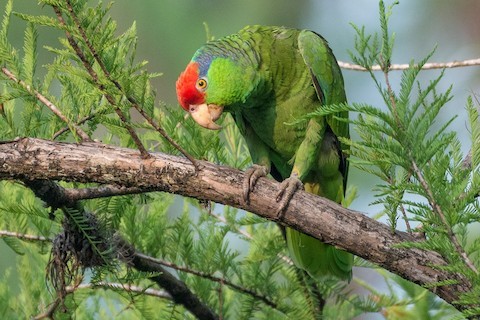
Red-crowned Parrot, male. (El Naranjo, San Luis Potosí, Mexico; May 8, 2019.) © Juan Miguel Artigas Azas
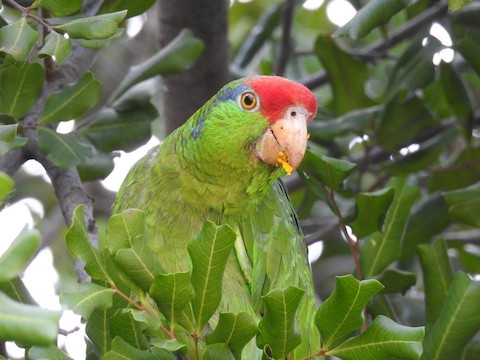
Red-crowned Parrot, male. (Occidental College, Los Angeles, California; May 3, 2019.) © James Maley
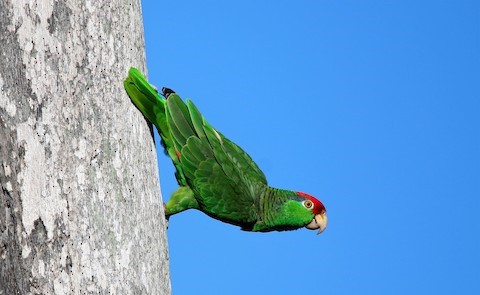
Red-crowned Parrot, male. (University of Texas – Rio Grande Valley, Brownsville, Texas; March 22, 2017.) © Madeleine Sandefur

Red-crowned Parrot, female emerging from nest cavity. (Brownsville, Texas; May 13, 2017.) © Simon Kiacz
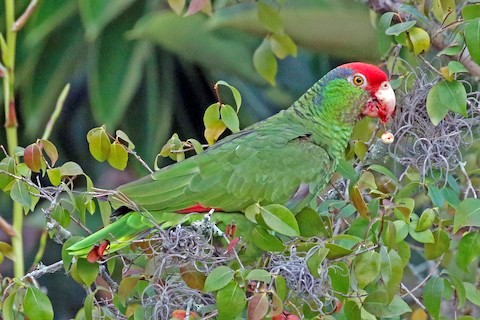
Red-crowned Parrot, male. (Fort Myers, Florida; March 29, 2020.) © David McQuade
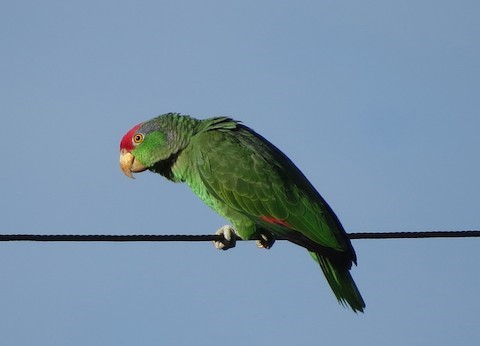
Red-crowned Parrot, male. (Altadena, California; December 31, 2017.) © Javier Vazquez
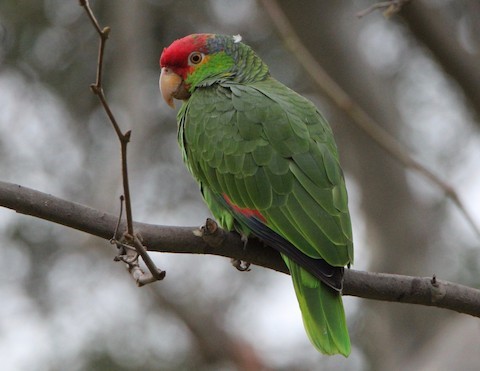
Red-crowned Parrot, male. (Irvine Regional Park, California; January 20, 2020.) Anonymous eBirder
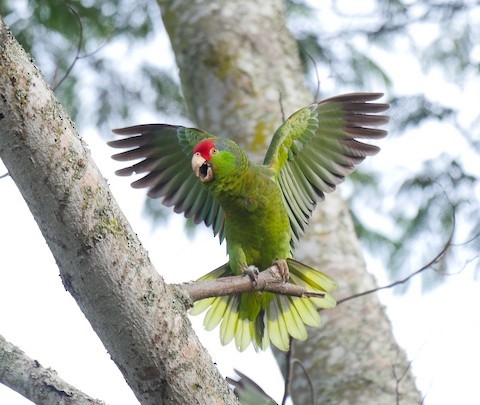
Red-crowned Parrot, showing spread tail with broad yellow tip. (Waimalu, Oahu, Hawaii; March 14, 2020.) © Nick Kalodimos
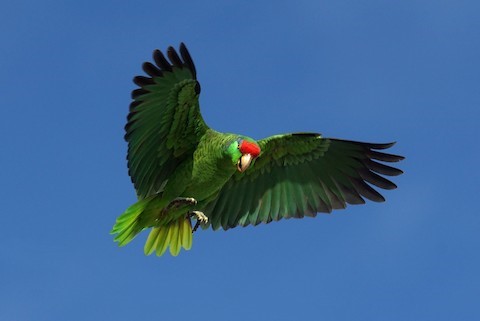
Red-crowned Parrot, showing green underwings with blacksh tips and trailing edges. (Palm Beach, Florida; March 29, 2019.) © Doris Guimond et Claude Gagnon
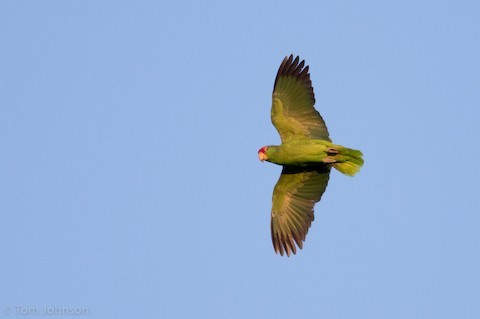
Red-crowned Parrot, in flight showing yellowish-green linings and darker green flight feathers with a blackish border that is broad at the tips and narrow along the trailing edge. (Oliveira Park, Brownsville, Texas; March 20, 2018.) © Tom Johnson
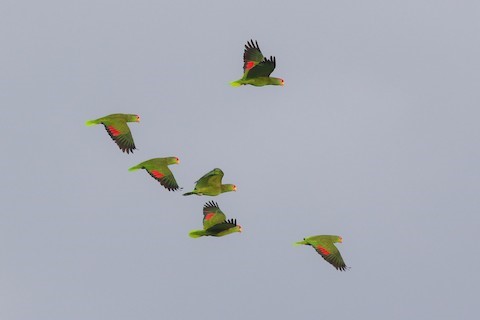
Red-crowned Parrots, in flight showing red wing panels. (Sunshine Strip, Harlingen, Texas; November 7, 2016.) © Michael O’Brien

Red-crowned Parrots, showing patterns on fully spread wings. (Waimalu, Oahu, Hawaii; March 14, 2020.) © Nick Kalodimos
References
Alderfer, J., and J.L. Dunn. 2014. National Geographic Complete Birds of North America (Second Edition). National Geographic Society, Washington, D.C.
BirdLife International. 2018. Amazona viridigenalis. The IUCN Red List of Threatened Species 2018: e.T22686259A131918910. https://dx.doi.org/10.2305/IUCN.UK.2018-2.RLTS.T22686259A131918910.en. (Accessed August 23, 2020.)
eBird. 2020. eBird: An online database of bird distribution and abundance. Cornell Lab of Ornithology, Ithaca, N.Y. http://www.ebird.org. (Accessed August 23, 2020.)
Forshaw, J.M. 2010. Parrots of the World. Princeton University Press, Princeton, N.J.
Howell, S.N.G., and S. Webb. 1995. A Guide to the Birds of Mexico and Northern Central America. Oxford University Press.
Juniper, T., and M. Parr. 1998. Parrots: A Guide to Parrots of the World. Yale University Press.
Kirwan, G.M., A. Levesque, M. Oberle, and C.J. Sharpe. 2019. Birds of the West Indies. Lynx Edicions, Barcelona.
Pyle, R.L., and P. Pyle. 2017. The Birds of the Hawaiian Islands: Occurrence, History, Distribution, and Status. Version 2 (January 1, 2017). http://hbs.bishopmuseum.org/birds/rlp-monograph/. B.P. Bishop Museum, Honolulu, Hawaii.
Xeno-Canto. 2020. Red-crowned Amazon – Amazona viridigenalis. https://www.xeno-canto.org/species/Amazona-viridigenalis. (Accessed August 23, 2020.)
